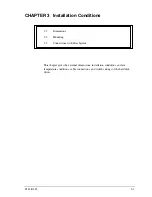
80
Test operation and gain adjustment of the PM sensorless vector control
· Adjust in the following procedure:
1) Change the
Pr. 820
setting while checking the conditions.
2) If it cannot be adjusted well, change
Pr. 821
setting, and perform 1) again.
(2) Troubleshooting
No.
Movement/condition
Adjustment Method
1
Load inertia is too high.
Set
Pr. 820
and
Pr. 821
higher.
Pr. 820
If acceleration is slow, raise the setting by 10%s and set a value that
satisfies the following condition: The setting immediately before vibration/
noise starts occurring
0.8 to 0.9
Pr. 821
If overshoots occur, raise the setting by double the setting and set a value
that satisfies the following condition: The setting where overshoots stop
occurring
0.8 to 0.9
2
Vibration or acoustic noise is
generated from machines.
Set
Pr. 820
lower and
Pr. 821
higher.
Pr. 820
Lower the setting by 10%s and set a value that satisfies the following
condition: The setting immediately before vibration/noise starts occurring
0.8 to 0.9
Pr. 821
If overshoots occur, raise the setting by double the setting and set a value
that satisfies the following condition: The setting where overshoots stop
occurring
0.8 to 0.9
3
Response is slow.
Set
Pr. 820
higher.
Pr. 820
If acceleration is slow, raise the setting by 5%s and set a value that satisfies
the following condition: The setting immediately before vibration/noise starts
occurring
0.8 to 0.9
4
Return time (response time)
is long.
Set
Pr. 821
lower.
Lower
Pr. 821
by half the current setting and set a value that satisfies the following
condition: The setting immediately before overshoots or unstable movements stop
occurring
0.8 to 0.9
5
Overshoots or unstable
movements occur.
Set
Pr. 821
higher.
Raise
Pr. 821
by double the current setting and set a value that satisfies the following
condition: The setting immediately before overshoots or unstable movements stop
occurring
0.8 to 0.9
Condition
Possible Cause
Countermeasure
1
Motor does not run at the correct
speed.
(Command speed and actual
speed differ.)
(1) Speed command from the
controller is different from
the actual speed.
The speed command is
affected by noise.
(2) The command speed and
the speed recognized by
the drive unit are different.
(1) Check that the speed command sent from the
controller is correct. (Take EMC measures.)
(2) Adjust bias and gain
(Pr. 125, Pr. 126, C2 to C7)
of the
speed command again.
2
The speed does not accelerate to
the command speed.
(1) Torque shortage
Stall prevention operation
is activated.
(2) Only P (proportion) control
is performed.
(1) -1 Raise the stall prevention operation level.
.)
(1) -2 Capacity shortage
(2) Speed deviation occurs under P (proportional)
control when the load is heavy. Select PI control.
3
Motor speed fluctuates.
(1) Speed command varies.
(2) Torque shortage
(3) Speed control gain is not
suitable for the machine.
(Resonance occurs.)
(1) Check that the speed command sent from the
controller is correct. (Take EMC measures.)
(2) Raise the stall prevention operation level.
(3) Adjust
Pr. 820
and
Pr. 821
(
.)
4
Hunting (vibration or acoustic
noise) occurs in the motor or the
machine.
(1) Speed control gain is too
high.
(2) Motor wiring is incorrect.
(1) Set
Pr. 820
lower and
Pr. 821
higher.
(2) Check the wiring.
Summary of Contents for FR-D720-0.2K-G
Page 45: ...34 MEMO ...
Page 293: ...290 MEMO ...
















































